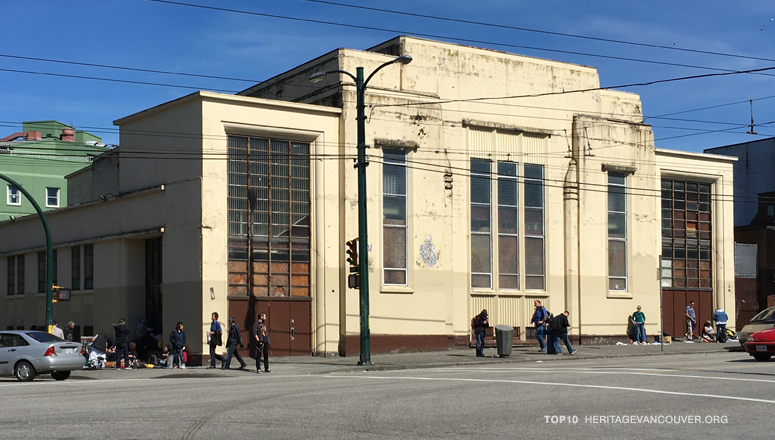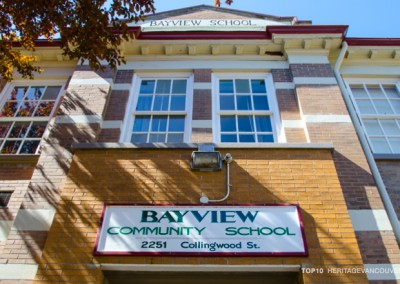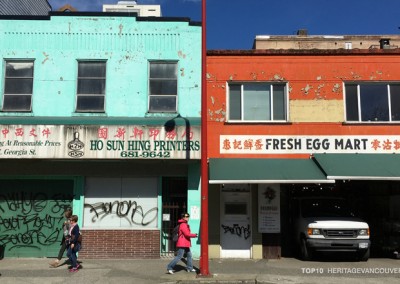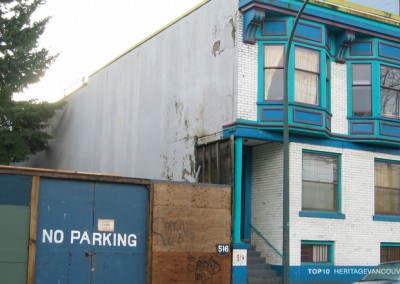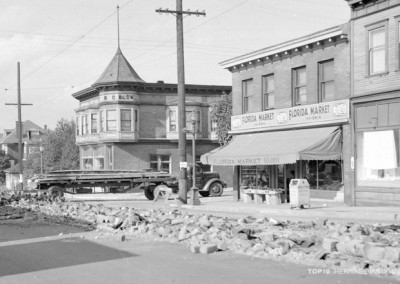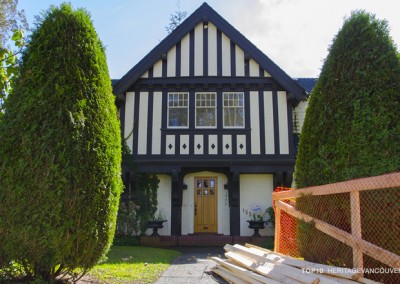Designed by architects Mercer & Mercer, the Salvation Army Temple, at 301 East Hasting Street, is one of the significant surviving Moderne buildings in Vancouver.
The Temple is also one of the last opportunities in the Downtown Eastside to convert a purpose-built assembly hall to community arts and cultural space. This site is already listed on the Vancouver Heritage Register.
BC Housing issued a Request for Proposals in December 2015 for redevelopment of this property to non-market housing. Demolition of the Salvation Army Temple would mean losing an irreplaceable modernist landmark.
Since the loss of the Pantages Theatre, this is the last significant historic purpose-built assembly building in the Downtown Eastside that has the potential for conversion into community cultural space.
Threat
What is the threat to the Salvation Army Temple?
After leaving the former Salvation Army Temple unused for 14 years, Coastal Health, and BC Housing, issued a Request for Proposals in December 2015 for redevelopment of the property to non-market housing units. There are active development applications to provide social housing on three of four corners of Hastings and Gore while the fourth corner is already a social housing building.
The potential demolition of the Temple to make way for redevelopment would mean the loss of one of Vancouver’s most significant Moderne buildings and an irreplaceable downtown landmark.
Vancouver would also lose one of the last opportunities to adapt a purpose-built assembly hall into needed cultural spaces in the Downtown Eastside, where the Carnegie Centre, Fire Hall Theatre and others have reached maximum capacity. There will be few other opportunities to provide cultural amenities for the area’s growing population.
Significance
Why is the Salvation Army Temple significant?
Designed by architects Mercer & Mercer, the Salvation Army Temple, at 301 East Hastings Street, is one of the most significant examples of the Moderne style in Vancouver.
The Temple is also a community landmark due to its corner location, size, scale, style and function.
The Temple opened in 1950, and was the Vancouver district headquarters at the same location as the original 1907 Provincial headquarters, serving British Columbia, the Yukon and Alaska. The Salvation Army was part of the heart of the early city with its social work, care and shelter for those in need, including food banks and missions. This location in Strathcona, Vancouver’s first neighbourhood, supported the multi-cultural working community that had developed near the working harbor and the railway.
When the Salvation Army made the decision to move from the Downtown Eastside in the 1980s, the building was sold to the Gold Buddha Monastery, which had a presence here from 1985-1993. Vancouver Coastal Health bought the property in 2001, and has left the Temple vacant, used for storage, since that time.
The Temple was designed around the large assembly hall, and also held, on the lower floor, a ‘young people’s assembly room’, small auditorium and gymnasium, classrooms and a library and a kitchen. Main floor space also provided the songsters’ room, band room, mothers’ room, women’s auxiliary and corps offices.
The Temple is now the last significant purpose-built assembly hall in the Downtown Eastside that could be converted into much-needed community cultural space.
Position
Heritage Vancouver’s position
Heritage Vancouver supports the retention of the Salvation Army Temple and its adaptive reuse as a community arts and cultural hub for the Downtown Eastside.
A more creative solution to this site should be determined, that incorporates its significant heritage value, as well as its unique cultural potential.
The Temple could accommodate a much-needed auditorium and theatre of approximately 500 seats and a cultural facility with arts programming space.
Existing facilities, such as the Carnegie Centre and the Firehall Arts Centre, are reaching their capacity and, as more residents move to the Downtown Eastside, cultural and other amenities must be provided to support the community.
We urge Vancouver Coastal Health and BC Housing to immediately halt the plans for demolishing this irreplaceable landmark, and look for innovative ways to repurpose it as a new cultural facility through community partnerships.
Actions
What you can do
We strongly encourage the citizens of Vancouver to:
- Contact Vancouver Coastal Health and BC Housing to protest the demolition of this irreplaceable, significant Moderne institutional landmark.
- Contact the Mayor, Council and City of Vancouver to express that this Heritage-Registered property should be assessed for its potential adaptive reuse as a cultural facility.
- Encourage the City of Vancouver to work with Vancouver Coastal Health and BC Housing to find another site for their proposed facility, while securing the Salvation Army Temple for community cultural space.
- Contact local civic, provincial and federal politicians to express that this public building should be retained for use as a cultural facility in an area where there is demonstrated need for arts programming space and community cultural spaces.
Resources
Vancouver social-housing proposal would nix art-deco building
John Mackie, Vancouver Sun; March 14, 2018
Heritage building’s future uncertain with social housing planned for site of old Salvation Army headqurters
Travis Lupic, Georgia Straight; November 1, 2016
Call for development proposals for old Salvation Army building at Hastings and Gore
Travis Lupic, Georgia Straight; January 26, 2016
‘Moderne’ Vancouver landmark endangered
John Mackie, Vancouver Sun; January 25, 2016
View article link
